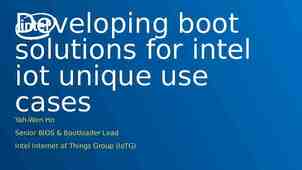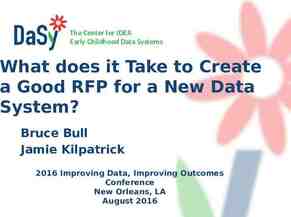SCBA – Commercial Lending for Lenders – 2022 “Just how do you
20 Slides67.81 KB
SCBA – Commercial Lending for Lenders – 2022 “Just how do you think you’ll be paid back on this loan, anyway?” Alan Whitecross [email protected]
What repays a loan? CASH – and only CASH! Therefore, we need to understand Cash Flow
Remember, the first task is to underwrite the transaction Where’s the primary source of repayment? It should be from the Borrower – and ‘matches’ the original purpose of the loan Does your Bank test the “affordability” of the transaction? Do you calculate the supportable loan amount in every term loan?
Understanding of Cash Flow All cash flow is a dynamic, living, thing: It needs to be reviewed and analyzed regularly This requires, therefore, new information regularly Make sure that you understand what stage in the company’s evolution you are reviewing: New company Growing company Mature company
Quick Summary of Differences between Fast Growth and Mature Growth Firms Growing firms borrow more than mature firms So, if your customer base is comprised of growing firms, we need to find a cash flow measure that works in growth scenarios The cash flow measure must determine The ‘5 – C’s of Credit’ Reliability of cash flow
Cash Flow Fantasies Every borrower has a core cash flow Predictable and reliable Stable and consistent Borrowers always pay back bank debt first Before they pay taxes and CAPEX? Before they pay their personal living expenses? Before they pay themselves draws and dividends? Before they pay unexpected costs—accidents, fires, floods, tornadoes, hurricanes, illness, etc.?
How Does Your Bank Determine Cash Flow? Traditional Net Income Non – Cash Expenditures EBITDA Net Income Interest Taxes Depreciation Amortization FAS 95 Global
So what cash flow to use? What cash flow measure will incorporate legitimate needs for: Working capital to acquire inventory and receivables to support sales growth CAPEX to acquire fixed assets to support growth Payment of income taxes Repayment of debt — principal and interest Stockholders’ expectations for dividends and share price appreciation
Traditional Cash Flow Consequences of using Traditional Cash Flow (TCF) to measure cash flow : TCF CFO only if: NWC always returns to its starting point, i.e. no growth But what if company does grow? Sales growth requires assets to support growth – Additional NWC investment – Additional CAPEX Additional NWC and fixed assets usually means additional borrowing to acquire assets
Traditional Cash Flow Consequences of using Traditional Cash Flow (TCF) to measure cash flow (cont.’d): NWC and CAPEX investments “compete” with debt repayment, particularly for cash in growing companies Adding back depreciation expense means no dollars available to replenish fixed assets Depreciation usually covers only about 50% of replacement costs TCF ignores NWC and CAPEX investment , so it overstates CF available to repay debt Now, looking at EBITDA
EBITDA Defined EBITDA spelled out: E B I T D A Sample Co. ( M) profit after taxes before . . interest expense taxes depreciation amortization EBITDA 20 7 10 7 1 45
But TCF and EBITDA add up to the same problem . . . E 20 B I 7 T 10 D 7 A 1 EBITDA 45 E D A TCF T I EBITDA 20 7 1 28 10 7 45
EBITDA’s Appeal— Why It’s Used Easy to calculate for banks Uses only P&L data, no balance sheet needed Bigger, positive number (typically) Offers larger number for value multiples Positive, stable number Investment banker mystique and cache Borrowers like EBITDA-based covenants Easy to calculate Hard to violate
EBITDA’s Drawbacks It’s not all available to service debt because: It ignores sales growth demands for o NWC o CAPEX It ignores taxes It ignores dividends Its’ use induces aggressive accounting tactics Its’ overstated CF leads to bad credit decisions EBITDA – based covenants don’t work
Quick Fixes to EBITDA Two solutions to EBITDA FASB-based cash flow from operations (CFO) o Accurate . . . o . . .But harder to calculate than EBITDA o Several variations on CFO NCAO NCI CADA Free cash flow (FCF) o Not quite as accurate, but maybe close enough o Starts with EBITDA, so easier to follow
Comparison of NCAO, NCI, and CADA NCAO, NCI, & CADA ( MM) 2008 2009 2010 – Cash collected from sales 566 616 666 – -production costs -460 -526 -537 – -operating costs - 82 -104 -123 – -other income (expenses) 5 22 25 net cash after operations (NCAO) 29 8 31 -existing interest expenses - 7 - 11 - 16 -dividends - 3 - 4 - 8 net cash income (NCI) 19 - 7 7 -existing principal repayment - 10 - 5 - 14 csh after dbt amrtzn (CADA) 9 - 12 - 7 -CAPEX for existing nt fxd assets - 37 -102 - 91 NCAO surplus (deficit) avail - 28 -114 - 98 for new debt
A Different Way . . . Let us consider the ‘5 – C’s of Credit’ and then: – Adding two more C’s to make a better loan “equation” for your Bank.
The 5 C’s Character Capacity Capital Conditions Collateral
The “Extra” C’s Credit – we are talking about the credit worthiness of the Borrower AND Guarantor Control – ability to manage the credit when changes occur in Regulations or laws
Homestudy Don’t Wait!!!! Start as soon as you can as it will allow you time to communicate with me on questions. This is where to write: [email protected]

























